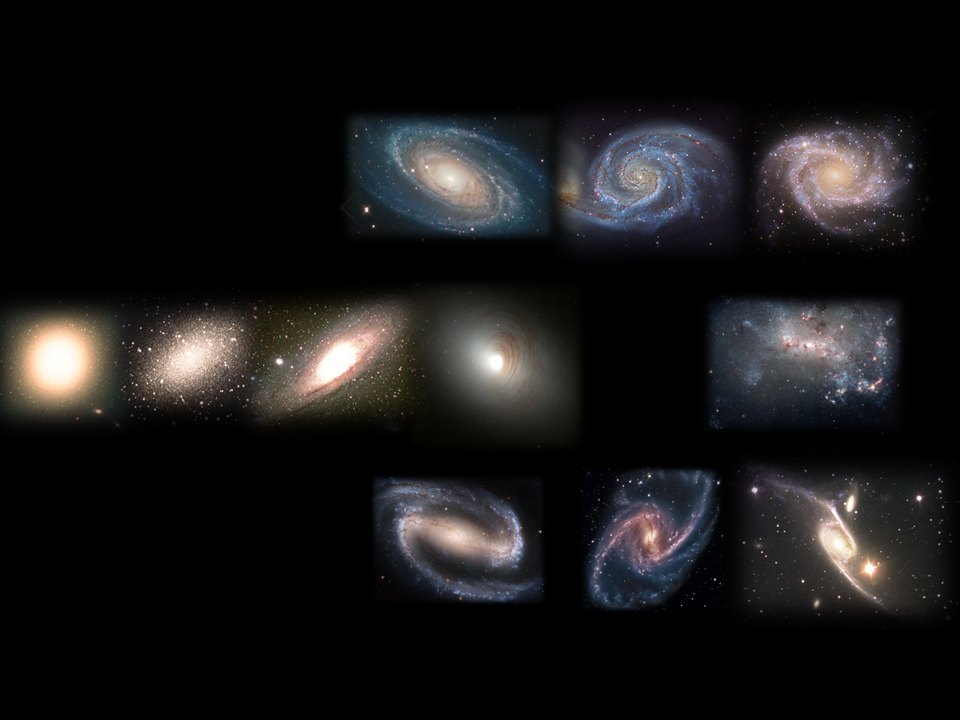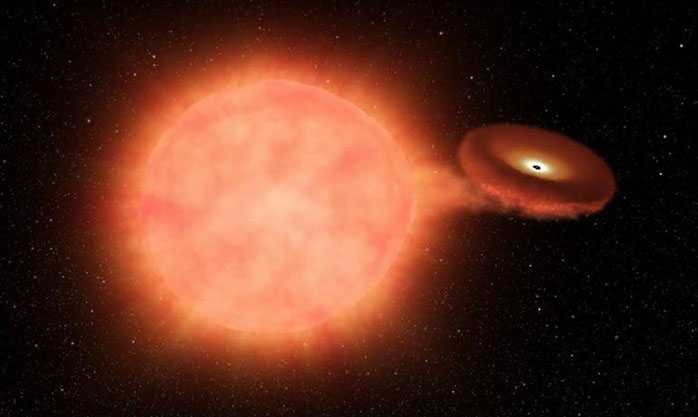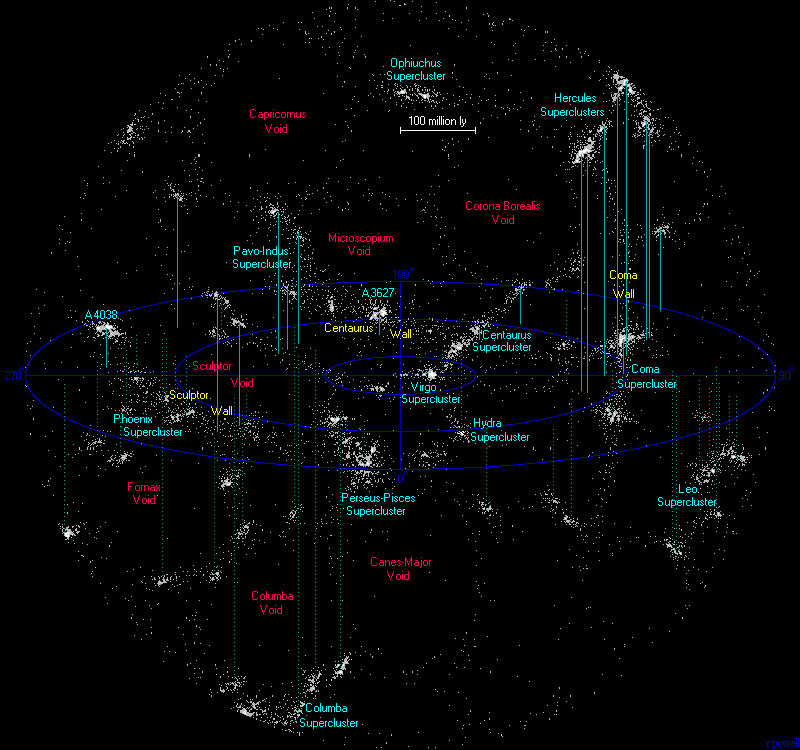
Galaxies


Hubble’s galaxy classification
EO
E4
ellipticals
E7
spirals
Sa
Sb
Sc
SBa
SBb
barred spirals
SBc
lenticular
irregular
The two main kinds of galaxies are elliptical (E) and spiral (S) galaxies.
Elliptical galaxies can be very much larger than spiral galaxies, and vary in ellipticity. The number after the E in the galaxy classification refers to the ellipticity of the galaxy. The roundest (most spherical) galaxies are called E0, slightly flatter are called E1, etc. The diagram above shows a few representative elliptical galaxies, increasing in flatness to the right. They usually have no disks, and are relatively structureless compared to spiral galaxies. There can also be very small, dwarf elliptical galaxies with less than a million stars. The dwarf elliptical galaxies far outnumber the giant elliptical galaxies.
Spiral galaxies are like our Milky Way galaxy, containing spiral arms extending from a central bulge. Some spiral galaxies contain an elongated bulge, or bar in the center and are designated "barred spiral galaxies" or SB, as opposed to normal spiral galaxies S. There is also a lower case letter following the S or SB, which further classifies the spiral galaxies. For normal spirals, the lower case letter denotes how tightly bound their spiral arms are. The most tightly bound spiral galaxies are denoted by Sa, while the looser galaxies are called Sb, Sc, etc. For the barred spiral galaxies, the lower case letter denotes the relative size of the central bulge, as well as the winding of the arms, with SBa being the largest bulge with the most tightly wound arms.
Irregular galaxies do not fit into either category of elliptical or spiral galaxies. Often the irregular shape of these galaxies indicates that they have undergone recent mergers (recent in the cosmological timescale) and have not yet evolved into a steady state elliptical or spiral galaxy.
Lenticular galaxies are flattened galaxies that have no apparent spiral arm structure. They typically have used up much of their gas and have little ongoing star formation, consisting of mostly old stars.
The "tuning fork" sequence of galaxy classification does not indicate evolutionary paths, as Hubble originally thought, but is still use as a general classification system for galaxies.
Extending the Cosmic Distance Ladder

© 2005 Pearson Prentice Hall, Inc
Our Cosmic Distance Ladder is useful out to 25 million parsecs, including information gained from variable stars such as Cepheid variables. We will extend our ability to measure cosmic distances out to 200 million parsecs using the Tully-Fisher relationship for rotating spiral galaxies. We will then extend our ability to measure distances out to 1 billion parsecs using Type Ia supernovae as standard candles.
Tully-Fisher relationship

The Tully-Fisher relationship is a method used to calculate distances to spiral galaxies. It is useful for galaxies that lie edge-on to us, or at least at a considerable angle. This means that as the galaxy rotates, one side is moving toward us while the other side is moving away. We can detect this by recognizing the Doppler-shifted spectrum of the light from the galaxy.
The spinning of the galaxy works against gravity, which is holding it together. The more massive a galaxy is, the faster it can spin without flying apart. We use this fact to relate the rotation of a galaxy to its mass. Also, the more massive the galaxy, the higher its luminosity, since it has more stars to shine.
In this way, measuring the Doppler shifts of a rotating galaxy allows us to measure its luminosity. Once we know the luminosity, we compare it to the apparent brightness to calculate its distance. The Tully-Fisher relationship extends our cosmic distance ladder to 200 million parsecs.
Type Ia supernovae

Recall that standard candles are very bright objects with known luminosities. Since we know the luminosity, we can calculate their distance. Type Ia supernovas are standard candles which extend our cosmic distance scale out to about a billion parsecs. Here's how it works:
When a small sunlike star reaches the end of its life, it does not have enough matter to explode in a core-collapse supernova. The outer parts puff out into a nebula and the core is left as a very hot white dwarf star. There is no fusion going on in the white dwarf. If the white dwarf has a binary partner, some time later, the partner will enter the red giant stage. When this happens, some of the tenuous matter of the extended red giant may actually be gravitationally drawn toward the white dwarf.
The matter streams onto the white dwarf and falls onto its surface or "accretes" onto the star. The accreting matter eventually builds up to the point where it exerts enough pressure to raise the temperature of the white dwarf to the point where fusion can take place. This is called a "nova." This fusion flares up and then runs out. The red giant matter keeps on accreting until the fusion happens again. It can happen over and over. Each time, the white dwarf gets a little more massive.
In time, if enough mass builds up on the white dwarf, the pressure and high temperature will do more than just cause fusion on the white dwarf's surface, it will cause the core to collapse and heat up tremendously, igniting fusion in the core. This is catastrophic for the white dwarf, blowing it up. When a white dwarf star blows up, it is a huge explosion, letting out a brilliant flash of light that lasts for several days.
Since all white dwarfs are about the same mass and the tipping point for fusion is about the same, the luminosity of the explosion is about the same. This means we can use them as standard candles. If we know the luminosity and measure the apparent brightness, we can calculate the distance.
-
Nova
- Starts with a white dwarf in a binary system with a red giant
- White dwarf accretes matter from the red giant
- Accreted matter builds up and heats up enough for fusion
- May be repeated
-
Type Ia supernova
- Starts with same situation as a nova (above)
- White dwarf builds up more mass over time
- Mass exceeds the Chandrasekhar limit
- Gravity overtakes electron degeneracy pressure
- Core collapses and heats up
- Carbon fusion begins and detonates star
3-D distribution of galaxies in space

This diagram shows the map of galaxies and galaxy clusters lying within 100 billion light years of our Milky Way. It is notable that galaxies are not strewn evenly in the sky, but rather there are very dense regions with clusters of dozens or hundreds of galaxies with huge empty spaces in-between. Filaments of galaxies connect the clusters in the large scale structure of the universe.
Please check out this NASA site for more information and check out the atlas of the universe link above for more maps of our local group, the Virgo supercluster and beyond.
We now begin our study of galaxies in general. We will begin by defining different types of galaxies, mainly spiral, elliptical and irregular galaxies. We will then extend our understanding of how to measure distances outward by use of the Tully-Fisher relationship relating the rotation speed of a spiral galaxy with its luminosity, using type Ia supernovae as standard candles, and finally, using the recession speeds of galaxies as a measure of their distances.
We will then study supermassive black holes, found at the centers of galaxies, paying special attention to those that are actively consuming matter.